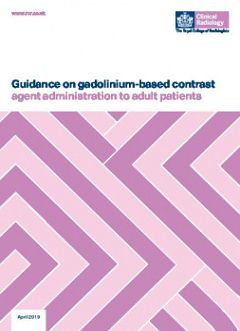The U.K. Royal College of Radiologists (RCR) has updated its guidance on the administration of gadolinium-based contrast agents (GBCAs) to adult patients. The 23-page document addresses concerns about possible long-term gadolinium retention in the brain and the risk of nephrogenic systemic fibrosis.
Background:Magnetic resonance imaging (MRI) is an indispensible method for clinical
diagnostic used for imaging inner organs. Almost every second MRI
examination worldwide is enhanced by application of a Gd-based contrast
agent (GBCA). GBCAs are used to enhance the
images and allow physicians interpreting the exam to distinguish blood
vessels from nearby tissue. Safety claims for the GBCAs are based on the
high stability of the agents and the high solubility leading to rapid
excretion in an intact state. However, a first safety issue was
recognized several years ago, when it was found that fast and complete
excretion is hindered among patients with impaired kidney function.
Development of adverse health conditions such as nephrogentic systemetic
fibrosis (NSF) under conditions of impaired excretion has been
reported. Yet, it was previously widely believed that GBCAs are rapidly
and completely excreted from the human body in patients with normal
kidney function. Yet in 2015 researchers found gadolinium in the brains of humans having received GBCAs before. Since than both the European Medicines Agency (EMA) and the US FDA have issued recommendations for radiologist for the safe administration of GBCAs.
The new guide:

This guidance looks in depth at important issues around the
administration of gadolinium-based contrast agents to adult patients,
addressing concerns around the potential for long-term gadolinium
retention in the brain and the risk of nephrogenic systemic fibrosis.
The authors of the report state that "the potential and theoretical risks of
intravenous administration of GBCAs for MRI must be weighed against the
potential benefits to the patient".
The guidance also clarifies that "GBCAs are associated with a very low rate of
immediate adverse events (0.06%-0.09%), and most adverse events are mild
and can be managed in the radiology department". "Major life-threatening contrast reactions to
GBCAs are extremely rare. The incidence of acute, severe reactions is
estimated to be 0.0025-0.005%."
Yet, "to minimise risk, it is important to identify
individuals at an increased risk of an adverse event. Appropriate steps
should always be taken to reduce the risk of contrast reactions."
The guidance provides eight key recommendations to support practitioners using
gadolinium-based contrast agents in the treatment of their patients and
covers safety, prescribing, consent, identification of patients at
increased risk from contrast administration, and pregnancy and lactation.
The key recommendations are as follows:
- An individual trained in recognizing and treating severe contrast
reactions, including anaphylaxis, should be immediately available for
the department where intravenous contrast is administered.
- A formal record of the decision to inject contrast should be made before administration.
- The individual administering the contrast must check that there are
no contraindications to its use and ensure that the patient understands
that it is to be given and agrees to the procedure.
- In cases where there is a previously reported moderately severe or
severe reaction to contrast, caution should be exercised and the need
for contrast should be re-examined with respect to an unenhanced study
or other potential methods of investigation.
- For elective examinations in patients who have a history of
previous contrast reactions, referral to a specialist drug allergy
service should be considered for assessment and testing against a panel
of contrast compounds to determine the safety of administration.
- The dose of GBCA should be minimized, taking into consideration the
indication, the patient's body weight, and the information from the
manufacturer contained in the summary of product characteristics. The
dose administered should be recorded electronically for audit purposes.
- When using GBCAs, knowledge of the patient's renal functional
status is generally advisable. GBCAs should be used with caution in
patients with severe chronic or acute renal impairment, in patients in
the perioperative liver transplantation period, and in neonates.
- Significant suspected contrast reactions should be formally
documented with full details, investigated appropriately with advice
given to the patient, and referral made to a specialist drug allergy
service to help guide future management.
 The cited guide:
The cited guide:
 Related EVISA News (newest first)
Related EVISA News (newest first)
last time modified: November 27, 2023